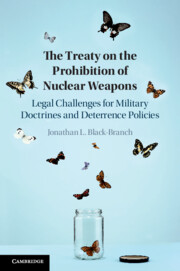 The Treaty on the Prohibition of Nuclear Weapons
The Treaty on the Prohibition of Nuclear Weapons Published online by Cambridge University Press: 17 April 2021
A legacy of the Cold War is that nuclear arms protect nations from attack; a stance that supporters of the TPNW wish to change. Indeed, this author would contend that nuclear weapons do not protect nations but actually threaten national, regional and global security. Many advocates of nuclear disarmament believe that the TPNW marks a new beginning; it was even celebrated with the Norwegian Nobel Peace Prize awarded to the International Campaign to Abolish Nuclear Weapons (ICAN), at the time, a relatively newly formed civil society organization. The TPNW demonstrates international support to take decisive action to eliminate nuclear weapons and the threat they pose to international peace and security.
To save this book to your Kindle, first ensure no-reply@cambridge.org is added to your Approved Personal Document E-mail List under your Personal Document Settings on the Manage Your Content and Devices page of your Amazon account. Then enter the ‘name’ part of your Kindle email address below. Find out more about saving to your Kindle.
Note you can select to save to either the @free.kindle.com or @kindle.com variations. ‘@free.kindle.com’ emails are free but can only be saved to your device when it is connected to wi-fi. ‘@kindle.com’ emails can be delivered even when you are not connected to wi-fi, but note that service fees apply.
Find out more about the Kindle Personal Document Service.
To save content items to your account, please confirm that you agree to abide by our usage policies. If this is the first time you use this feature, you will be asked to authorise Cambridge Core to connect with your account. Find out more about saving content to Dropbox.
To save content items to your account, please confirm that you agree to abide by our usage policies. If this is the first time you use this feature, you will be asked to authorise Cambridge Core to connect with your account. Find out more about saving content to Google Drive.